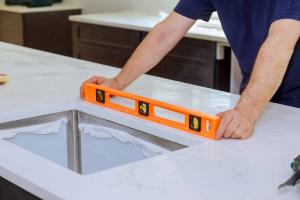Mastering the Art of Installing Granite Countertops: A Comprehensive Guide

-
Quick Links:
- Introduction
- Essential Materials and Tools
- Preparation Steps
- Removing Old Countertops
- Measuring and Cutting Granite
- Installing the Countertops
- Finishing Touches
- Granite Countertop Maintenance
- Case Study: A Successful Granite Installation
- Expert Insights
- FAQs
Introduction
Granite countertops have long been a favored choice for homeowners and chefs alike due to their durability, elegance, and timeless appeal. Installing granite countertops, however, can seem daunting. With the right knowledge, tools, and preparation, you can master this skill and elevate your kitchen or bathroom to new heights. In this comprehensive guide, we will walk you through the entire process of installing granite countertops, from preparation to maintenance, ensuring you achieve a professional finish.
Essential Materials and Tools
Before you begin, gather the necessary materials and tools:
- Materials:
- Granite slabs
- Adhesive (epoxy or silicone)
- Sealer
- Backer board (if needed)
- Tools:
- Measuring tape
- Level
- Utility knife
- Wet saw or angle grinder
- Caulking gun
- Grout float
- Safety goggles and gloves
- Vacuum cleaner
Preparation Steps
Preparation is critical for a successful installation. Follow these steps:
- Measure the area where the granite will be installed. Consider the layout and any cut-outs needed for sinks or appliances.
- Remove all items from the countertops to ensure a clean workspace.
- Decide on the type and color of granite that matches your aesthetic.
Removing Old Countertops
To install new granite, you first need to remove the existing countertops:
- Turn off any plumbing and disconnect appliances.
- Carefully pry off the old countertop, starting from the edges. Use a utility knife to cut any caulking that may be adhering the countertop to the cabinets.
- Remove any screws or brackets holding the countertop in place.
- Clean the surface of the cabinets thoroughly, removing dust and debris.
Measuring and Cutting Granite
Getting precise measurements is crucial for a seamless installation:
- Measure the countertop space, noting any spots for sinks or appliances.
- Transfer these measurements to the granite slab. Use a chalk line for accuracy.
- Cut the granite using a wet saw. Always wear safety goggles and gloves during this process.
Installing the Countertops
With the granite ready, it's time to install:
- Apply the adhesive to the cabinet surface where the granite will sit.
- Carefully place the granite slabs onto the adhesive. Use a level to ensure they are even.
- Secure the slabs using clamps as needed. Allow the adhesive to set as per the manufacturer's instructions.
Finishing Touches
Once the granite is installed, focus on the details:
- Apply caulk around the edges for a polished look.
- Seal the granite with a high-quality sealer to protect against stains.
- Allow the sealer to cure for the recommended time.
Granite Countertop Maintenance
To keep your granite countertops looking beautiful:
- Clean regularly with a mild detergent and water.
- Avoid harsh chemicals that may damage the surface.
- Reapply the sealer every year or as needed.
Case Study: A Successful Granite Installation
In a recent home renovation project in Austin, Texas, homeowners Sarah and John decided to upgrade their kitchen with granite countertops. They chose a beautiful black granite with white specks. With the help of this guide, they successfully installed the countertops themselves, saving on labor costs. The end result not only enhanced the aesthetic appeal of their kitchen but also increased their home’s value significantly.
Expert Insights
We spoke to Alex Thompson, a certified interior designer with over 15 years of experience in kitchen renovations. He emphasizes the importance of proper installation: “Granite is an investment. Taking the time to install it correctly ensures it lasts a lifetime.” Alex also advises choosing a sealer that suits the specific type of granite, as different stones have varying permeability.
FAQs
1. How long does it take to install granite countertops?
Typically, the installation can take a full day, but it may vary depending on the complexity of the project.
2. Can I install granite countertops myself?
Yes, with the right tools and knowledge, DIY installation is possible, but hiring professionals is recommended for complex projects.
3. What is the average cost of granite countertops?
The cost varies widely based on the type of granite but generally ranges from $40 to $100 per square foot, including installation.
4. How heavy are granite countertops?
Granite weighs about 15 to 20 pounds per square foot, so ensure your cabinets can support the weight.
5. Do I need to seal granite countertops?
Yes, sealing granite is essential to prevent stains and maintain its beauty.
6. What tools do I need for installation?
You will need a wet saw, level, caulking gun, measuring tape, and safety gear among other tools.
7. How do I clean granite countertops?
Use a mild detergent and warm water with a soft cloth to clean granite surfaces.
8. Can granite countertops chip or crack?
While granite is durable, it can chip or crack if heavy objects are dropped on it or if it is subjected to extreme temperature changes.
9. What are the best colors for granite countertops?
Popular colors include black, white, beige, and gray, but the choice depends on personal preference and kitchen decor.
10. How can I make my granite countertops shine?
Use a granite polish or a mixture of water and baking soda to buff the surface and enhance its shine.
Random Reads
- Mastering the art of folding and storing your ironing board
- How to install bathroom sink
- Mastering text outlining and borders in photoshop
- How to remove laptop screen
- Ultimate guide to spring cleaning your room
- How to install sliding closet doors
- How to install skyrim mods
- How to reinstall windows xp without cd
- How to install a motherboard
- How to install a built in dishwasher